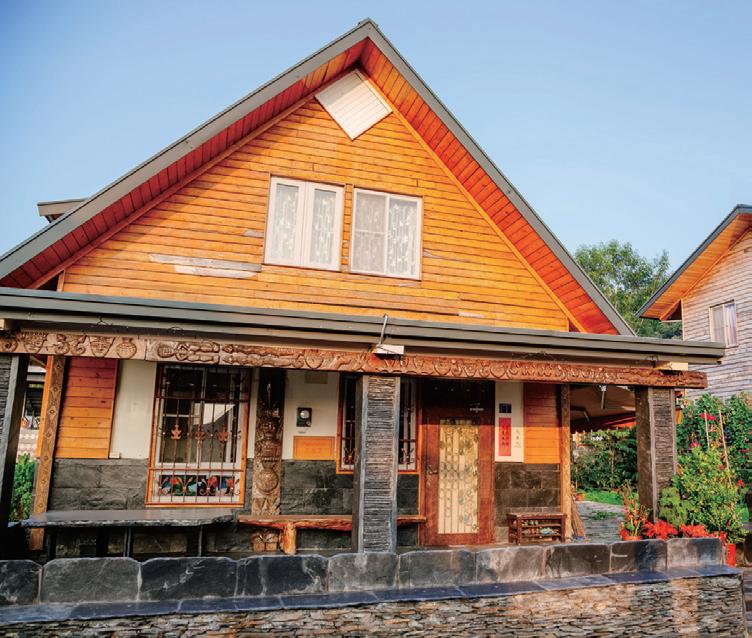
2 minute read
Lrimumu Teke
This shop, and the one below, face each other across Provincial Highway No. 24 in a settlement just west of, and lower in elevation than, the one we’ve just visited. Collectively the two enclaves are commonly referred to as the Upper Wutai Community. These two food-andbeverage operations are popular stopping-off joints for tourists exploring the region.
As you approach Lrimumu Teke, it’s clear what the signature offering is at this open-front vendor – visuals of delectable donuts abound. The specialty is deep-friedbefore-you doughnuts, topped with powdered sugar, made with millet. Foxtail millet is a staple crop for the Rukai and other Taiwan tribes, used to make wine and in foods such as cinavu (meat mixed with fermented millet and powdered taro wrapped in leaves and cooked), and celebrated at their renowned annual millet harvest festival.
Advertisement


Shenshan Aiyu
While Lrimumu Teke is set up on the stone-fenced narrow porch of a slate-façade residence, Shenshan Aiyu is set up in a street-facing courtyard fronted by the traditional-style low stone fencing.


A cooling bowl of aiyu jelly is a favorite Taiwan summer treat. Here it’s combined with another beloved summer tradition, shaved ice, which is served with various sweetened goodies. On the menu are aiyu jelly ice with persimmon and lemon, with fermented millet, and with mung bean, as well as the signature creation, assorted (i.e., all of the above gems) aiyu jelly. In the courtyard is rustic Rukai-style seating at tables/benches made with thick slate slabs, and on the residence’s roof is shaded picnictable seating from which patrons can look out over the settlement’s lower farm-grid area into the deep valley abyss.
Aiyu jelly is made from the seeds of a creeping vine fig that flourishes in forest 1,200~1,900m in elevation.


SHENSHAN AIYU ( 神山愛玉 ) www.facebook.com/Wutairukai
0933-684-700 No. 16-1, Shenshan Lane, Wutai Village, Wutai Township, Pingtung County ( 屏東縣霧台鄉霧台村神山巷 16 之 1 號 ) 9am ~ 5pm (closed on Mon. and Tue.)
LRIMUMU TEKE ( 莉姆姆的歌 )
(08) 799-7171
No. 23, Shenshan Lane, Wutai Village, Wutai Township, Pingtung County ( 屏東縣霧台鄉霧台村神山巷 23 號 )
1pm ~ 6pm (from 9am on Sat. and Sun., closed on Mon.) www.facebook.com/LimumuTEKE
Rinari Village
Just southwest of the park is Rinari Village, a slopeland settlement that looks over the plains. Western, especially European, visitors will experience a sense of the familiar-yet-exotic here. The neat grid of tidy streets sports copycat-design A-frame and twin homes, all two stories, all wood-built. This young place is a resettlement of three high-mountain Rukai/Paiwan villages that suffered severe damage in an infamous 2009 typhoon. In striking yet harmonious contrast with the European-style architecture is each abode’s traditional Rukai/Paiwan slate-built patio, complete with low slate-slab fencing and seating, which tribal members call their “living rooms.” The exteriors of many homes are standalone artworks, brilliant with etchings, paintings, and drawings depicting the stories, customs, and histories of the resident clans.
The tribe’s younger generation has developed Rinari as a tourist-beckoning attraction, and you can experience guided tours, song-and-dance sessions, handicraft DIY, indigenous-fare dining both simple and upscale, and home-based shops selling traditional-style crafts created by masterly matriarchs.

Majia Township
Taiwan Indigenous Peoples Cultural Park


As you approach the gaping Ailiao River valley mouth while crossing the wide Gaoping River plain, you get views of a settlement prominently laid out on a plateau on its north side. This is Sandimen, perhaps the region’s most tourist-visited indigenous village.
Our quest here, however, is the attraction spread out on a plateau on the opposite side, the Taiwan Indigenous Peoples Cultural Park. This is one of the world’s biggest theme parks focused on indigenous cultures, with a splendrous scope of knowledge-enhancing and entertaining experiences. There are first-rate replicas of traditional Taiwan indigenous architecture, dynamic song-and-dance performances, a museum dedicated to the potent sculptural artistry of the many different tribal peoples, DIY workshops where you create your own indigenous-style handicrafts, a hiking trail to higher ground and a park overlook, and freshcooked native foods aplenty, featuring many ingredients you will no doubt not have come across before.









